Hartford Financial Services Bundle
How Does The Hartford Thrive in Today's Market?
The Hartford Financial Services Group, Inc., a titan in the insurance and financial services arena since 1810, offers a wide array of services, including property-casualty insurance, group benefits, and mutual funds. With a recent TTM revenue of $26.926 billion, reflecting a 7.55% year-over-year increase ending March 31, 2025, understanding its operational mechanics is key. Its enduring presence and diverse offerings highlight its significance in safeguarding assets and ensuring financial stability for its customers.
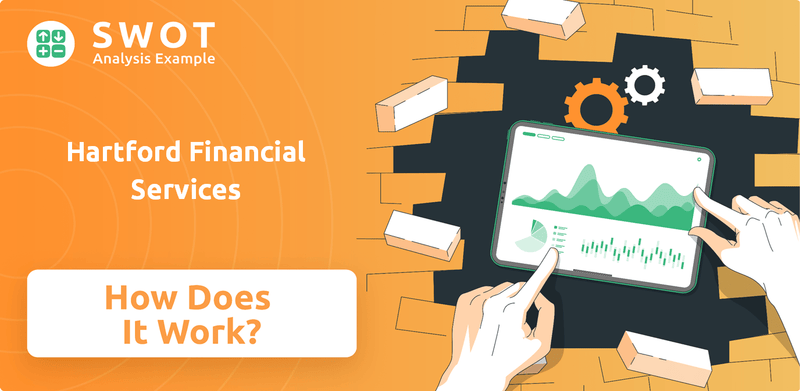
Delving into Hartford Financial Services SWOT Analysis will reveal how the company navigates the complexities of the insurance sector. This analysis will explore its diverse revenue streams, including Hartford insurance policies and products, and the strategic initiatives that have fueled its growth. Whether you're curious about Hartford auto insurance, or seeking details on Hartford life insurance policy, this exploration provides insights into the company's strategies and its competitive standing in the market. The Hartford company's commitment to customer service and its robust financial performance make it a compelling subject for those interested in the insurance industry.
What Are the Key Operations Driving Hartford Financial Services’s Success?
The core operations of The Hartford are structured to create and deliver value through its key segments: Business Insurance, Personal Insurance, Employee Benefits, and Hartford Funds. These segments serve a diverse customer base, including small to mid-sized businesses, individuals, and large corporations. The company's approach emphasizes leveraging technology and data analytics to enhance customer experiences and tailor insurance solutions.
The Hartford's value proposition centers on providing comprehensive insurance and investment products, supported by advanced technological capabilities. This strategy aims to improve pricing, streamline customer interactions, and offer customized insurance plans. The company's digital capabilities, particularly in the small commercial sector, are a key differentiator, contributing to its competitive advantage.
The company's operational processes are significantly enhanced by investments in technology, data analytics, cloud infrastructure, and artificial intelligence (AI). AI algorithms are used to streamline operations and reduce manual intervention in processing insurance applications and identifying customer requests. Data analytics help identify coverage gaps for clients, enabling the creation of customized insurance plans. The focus on technology and data-driven insights translates into benefits such as improved pricing and enhanced customer experiences. The Hartford's commitment to these areas is reflected in its financial performance and market position.
Offers a range of products including workers' compensation, property, automobile, and professional liability insurance. It caters to the needs of businesses of various sizes, providing them with essential risk management solutions. The segment is designed to help businesses protect their assets and manage potential liabilities effectively.
Provides automobile, homeowners, and umbrella insurance coverage to individuals. This segment focuses on offering individuals protection for their homes, vehicles, and personal assets. The Hartford aims to provide comprehensive and reliable insurance options for personal needs.
Delivers group life, accident, and disability coverage, along with voluntary benefits and group retiree health solutions. This segment serves employers by providing a suite of benefits that support their employees' well-being. The Hartford aims to offer comprehensive and flexible benefit options.
Offers investment products for retail and retirement accounts, alongside investment management, distribution, and administrative services. This segment focuses on providing investment solutions and services to help individuals and institutions achieve their financial goals. It supports various investment needs.
The Hartford continues to invest in digital capabilities and data analytics to improve customer experiences and operational efficiency. These investments support the company's strategy to offer competitive insurance products and services. For example, in 2024, The Hartford reported strong financial results, with a focus on disciplined underwriting and expense management. To understand how The Hartford compares to its competitors, consider reading about the Competitors Landscape of Hartford Financial Services.
- Digital Transformation: The company is focused on enhancing its digital platforms to improve customer interactions and streamline processes.
- Data Analytics: Utilizing data to identify coverage gaps and create customized insurance plans.
- AI Integration: Implementing AI to automate processes and improve decision-making.
- Customer Focus: Prioritizing customer needs through tailored insurance solutions and improved service.
Hartford Financial Services SWOT Analysis
- Complete SWOT Breakdown
- Fully Customizable
- Editable in Excel & Word
- Professional Formatting
- Investor-Ready Format
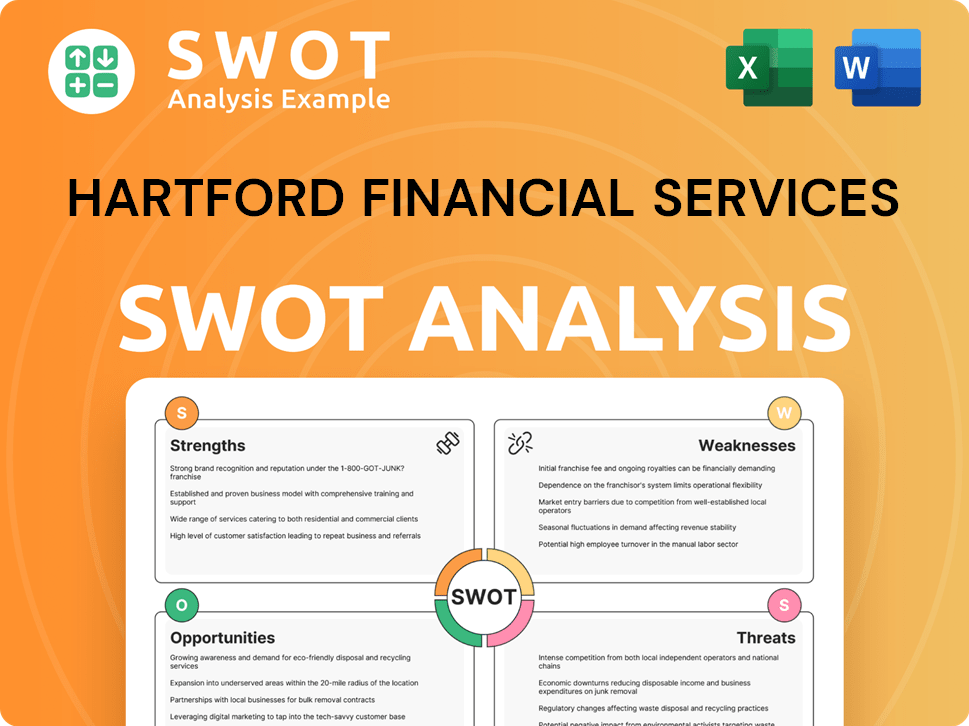
How Does Hartford Financial Services Make Money?
The Hartford Financial Services Company generates revenue through a diversified approach, primarily focusing on its Property and Casualty (P&C), Employee Benefits, and Hartford Funds segments. For the trailing twelve months ending March 31, 2025, the company reported a total revenue of $26.926 billion, showcasing its significant market presence.
The company's revenue streams are strategically designed to capture diverse market opportunities, ensuring financial stability and growth. These strategies include disciplined underwriting and pricing, focusing on new business sales, and leveraging technology and AI to enhance efficiency. The company's financial performance is a testament to its robust business model.
The Hartford's monetization strategies are multifaceted, ensuring sustained revenue generation and profitability. This approach includes a focus on premium growth, investment income, and operational efficiency. The company's ability to adapt and innovate is key to its continued success in the competitive insurance market.
This segment is the largest revenue driver for The Hartford. It includes Commercial and Consumer Property & Casualty, and investment income from premiums. Projected to contribute approximately $19 billion, or 69% of total revenues in fiscal year 2025.
Revenue comes from fully insured ongoing premiums. This segment is expected to generate about $7.4 billion, or 26% of total revenues in FY2025. The segment saw a 2% increase in 2024.
This segment is anticipated to contribute around $1.4 billion, representing 5% of total revenues in FY2025. It includes revenue from mutual funds and corporate activities.
The Hartford's monetization strategies include disciplined underwriting and pricing execution. This contributes to earned premium growth. The company focuses on increasing new business sales and maintaining high persistency rates in existing accounts.
In the first quarter of 2025, Property & Casualty written premiums increased by 9%. Business Insurance and Personal Insurance premium growth was 10% and 8% respectively. This demonstrates the company's effective pricing and underwriting strategies.
Net investment income, excluding limited partnerships, increased 7% to $617 million before tax in the first quarter of 2025, compared to the first quarter of 2024. This highlights the importance of investment strategies.
The Hartford's financial success is underpinned by several key strategies and metrics. These include premium growth, investment income, and operational efficiency. The company's focus on customer retention and technological advancements further enhances its financial performance.
- Persistency Rates: Persistency in Employee Benefits exceeds 90%, indicating strong customer retention.
- Technology and AI: Leveraging technology and AI to enhance underwriting accuracy and pricing.
- Customer Service: The Hartford is committed to providing excellent customer service, as highlighted in reviews and ratings. For more information on their target market, you can read about Target Market of Hartford Financial Services.
- Claims Process: The company streamlines the claims process to ensure customer satisfaction and efficient resolution.
Hartford Financial Services PESTLE Analysis
- Covers All 6 PESTLE Categories
- No Research Needed – Save Hours of Work
- Built by Experts, Trusted by Consultants
- Instant Download, Ready to Use
- 100% Editable, Fully Customizable
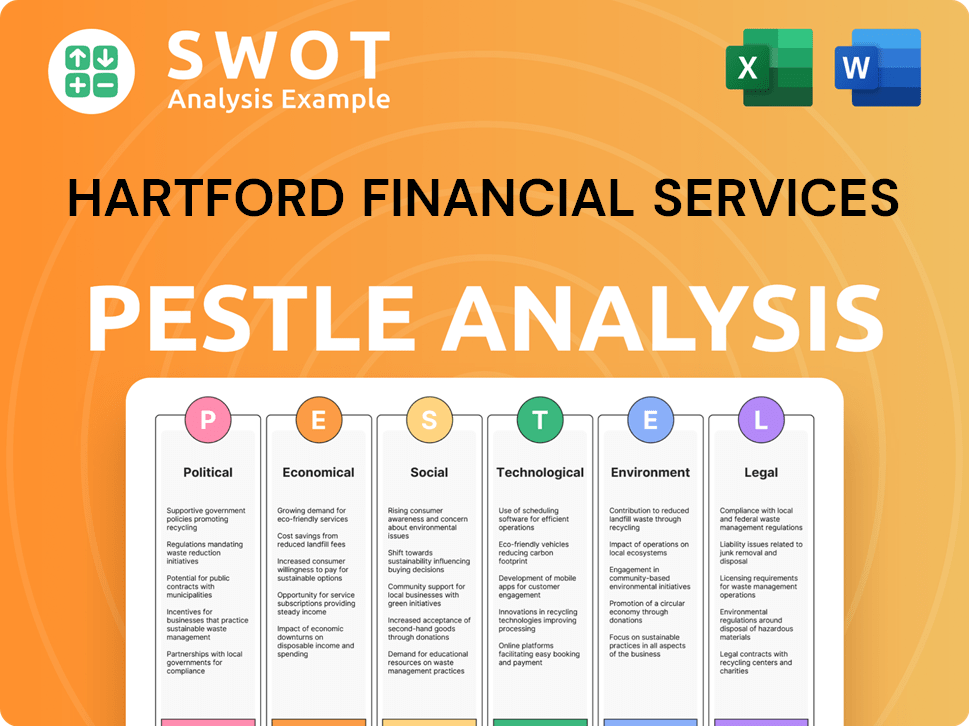
Which Strategic Decisions Have Shaped Hartford Financial Services’s Business Model?
The Hartford Financial Services has strategically navigated the insurance landscape through key milestones and strategic initiatives. A pivotal move is the 'Hartford Next' plan, an operational transformation and cost reduction strategy. This plan involves significant investments in digital technologies, data analytics, cloud computing, and artificial intelligence to streamline operations and improve efficiency.
The company has consistently demonstrated robust financial performance. For the full year of 2024, core earnings reached $3.1 billion, with a core earnings return on equity (ROE) of 16.7%. Despite facing challenges, such as the $325 million in losses from the January 2025 California wildfires, the company maintained strong core earnings of $639 million in the first quarter of 2025.
The company's focus on adapting to market demands is evident through its investment in technological advancements. These advancements include predictive analytics, big data, and AI, which are utilized to enhance underwriting, pricing, and customer service, ensuring the company remains competitive and responsive to evolving industry trends.
In March 2024, The Hartford restructured its Technology and Operations divisions under new leadership to advance strategy and improve customer value. The company's financial resilience is highlighted by its strong core earnings, even amidst challenges such as catastrophe losses. The company's strategic decisions and financial results demonstrate its commitment to sustainable growth and operational excellence.
The 'Hartford Next' initiative is a significant strategic move, focusing on digital transformation and cost reduction. This involves substantial investments in technology to improve efficiency and customer service. The company's proactive approach to technology and operational improvements underscores its commitment to adapting to the evolving insurance landscape.
The Hartford maintains a competitive edge through its strong brand and market presence, especially in Business Insurance. Its diversified product portfolio across different segments provides a competitive advantage. The company's consistent ranking as the number one Small Commercial carrier in overall digital capabilities for six consecutive years further strengthens its competitive position.
The company's strong financial health is evident in its full-year 2024 core earnings of $3.1 billion and a core earnings ROE of 16.7%. The Personal Insurance segment saw a 6.4-point underlying combined ratio improvement in the first quarter of 2025. These figures reflect the company's robust financial management and its ability to navigate market challenges effectively.
The Hartford leverages its strong brand recognition and a diversified product portfolio to maintain a competitive edge in the insurance market. The company’s investments in technology, including predictive analytics and AI, further enhance its underwriting and customer service capabilities. These strategies enable the company to adapt to market changes and improve operational efficiency.
- Strong brand power and market presence, especially in Business Insurance.
- Diversified product portfolio.
- Consistent ranking as a top Small Commercial carrier in digital capabilities.
- Proactive investment in technological advancements.
Hartford Financial Services Business Model Canvas
- Complete 9-Block Business Model Canvas
- Effortlessly Communicate Your Business Strategy
- Investor-Ready BMC Format
- 100% Editable and Customizable
- Clear and Structured Layout
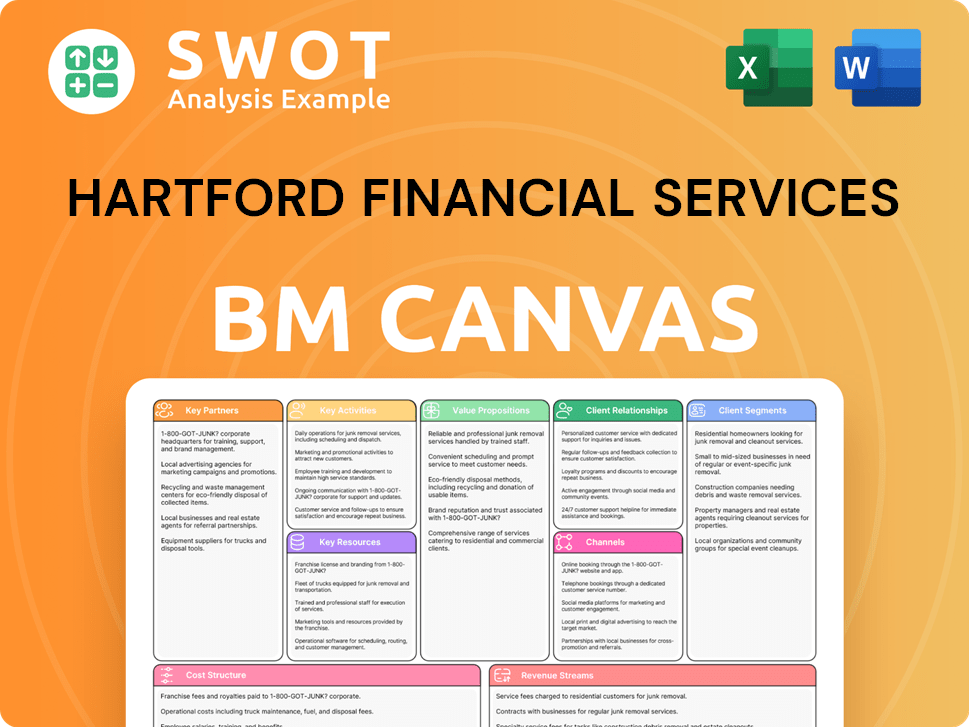
How Is Hartford Financial Services Positioning Itself for Continued Success?
The Hartford Financial Services Company holds a robust position in the insurance and financial services sector. It is recognized as a leader in property and casualty insurance, employee benefits, and mutual funds. Its strong brand and diverse distribution networks support its market share. The company's success is driven by its performance in various segments, especially its small commercial business.
However, The Hartford faces several challenges. These include increased competition, particularly in small commercial and personal auto insurance, which can lead to pricing pressures. Economic downturns could affect investment income, and the evolving regulatory environment presents ongoing obstacles. Catastrophe losses, such as the $467 million pre-tax losses in the first quarter of 2025, also pose a significant risk.
The Hartford is a key player in property and casualty insurance, employee benefits, and mutual funds. Its strong brand and distribution channels support its market share. The company's focus on small commercial business is a cornerstone of its growth.
The company faces intense competition, particularly in personal auto and small commercial sectors. Economic downturns and regulatory changes pose risks. Catastrophe losses, such as the $325 million from California wildfires, significantly impact financial results.
The Hartford anticipates higher net investment income in 2025 compared to 2024. The company aims for profitability in its personal auto segment by mid-2025. Strategic initiatives include technology investments and expanding market share.
The company has a share buyback program, with $2 billion remaining from the $3 billion authorized by the end of 2024. The ability of the Hartford to sustain profitability depends on its disciplined underwriting and strategic investments. For more insights, see the Marketing Strategy of Hartford Financial Services.
The Hartford is focusing on technology and AI to drive growth, particularly in personal lines. Strategic initiatives include advanced underwriting capabilities and end-to-end transformation. The company is also maximizing distribution channels to increase market share.
- Investing in technology and AI to drive growth.
- Advancing underwriting capabilities.
- Maximizing distribution channels and product breadth.
- Focusing on profitability in the personal auto segment by mid-2025.
Hartford Financial Services Porter's Five Forces Analysis
- Covers All 5 Competitive Forces in Detail
- Structured for Consultants, Students, and Founders
- 100% Editable in Microsoft Word & Excel
- Instant Digital Download – Use Immediately
- Compatible with Mac & PC – Fully Unlocked
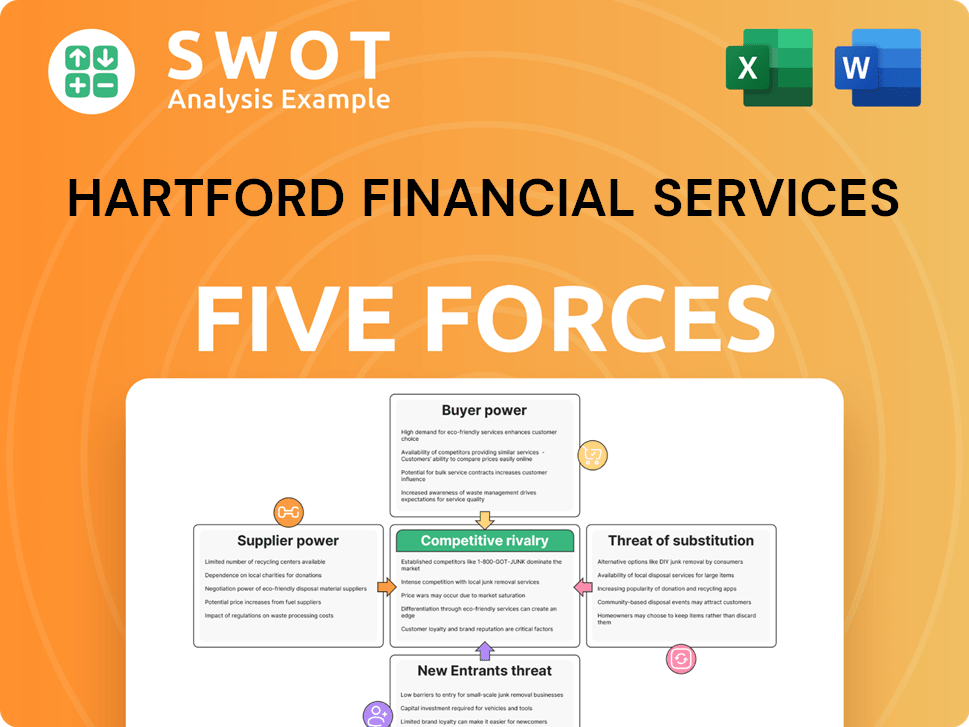
Related Blogs
- What are Mission Vision & Core Values of Hartford Financial Services Company?
- What is Competitive Landscape of Hartford Financial Services Company?
- What is Growth Strategy and Future Prospects of Hartford Financial Services Company?
- What is Sales and Marketing Strategy of Hartford Financial Services Company?
- What is Brief History of Hartford Financial Services Company?
- Who Owns Hartford Financial Services Company?
- What is Customer Demographics and Target Market of Hartford Financial Services Company?
Disclaimer
All information, articles, and product details provided on this website are for general informational and educational purposes only. We do not claim any ownership over, nor do we intend to infringe upon, any trademarks, copyrights, logos, brand names, or other intellectual property mentioned or depicted on this site. Such intellectual property remains the property of its respective owners, and any references here are made solely for identification or informational purposes, without implying any affiliation, endorsement, or partnership.
We make no representations or warranties, express or implied, regarding the accuracy, completeness, or suitability of any content or products presented. Nothing on this website should be construed as legal, tax, investment, financial, medical, or other professional advice. In addition, no part of this site—including articles or product references—constitutes a solicitation, recommendation, endorsement, advertisement, or offer to buy or sell any securities, franchises, or other financial instruments, particularly in jurisdictions where such activity would be unlawful.
All content is of a general nature and may not address the specific circumstances of any individual or entity. It is not a substitute for professional advice or services. Any actions you take based on the information provided here are strictly at your own risk. You accept full responsibility for any decisions or outcomes arising from your use of this website and agree to release us from any liability in connection with your use of, or reliance upon, the content or products found herein.